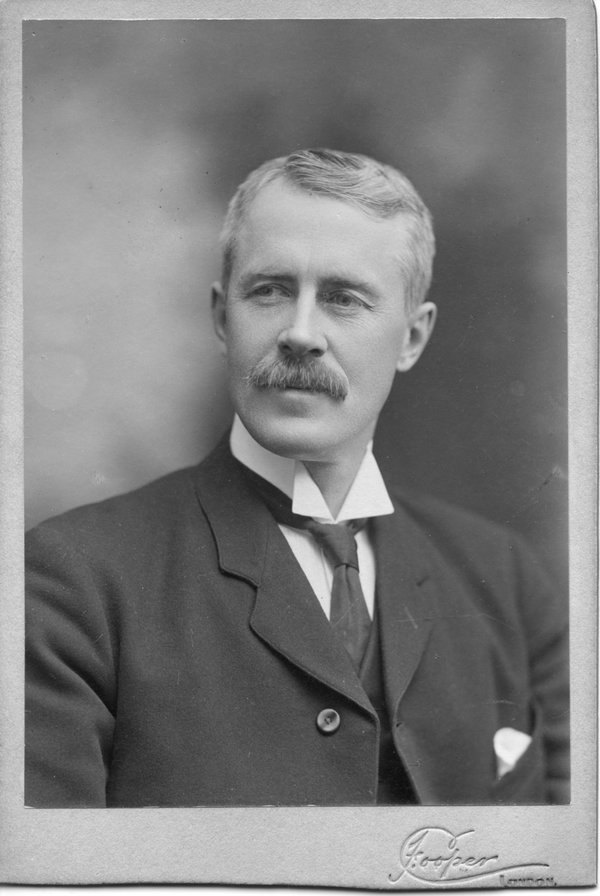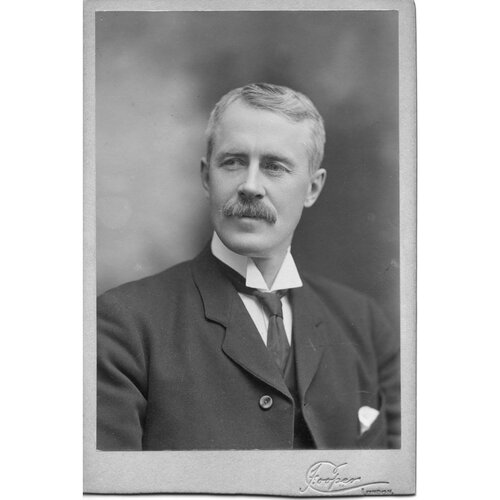
Source: Link
EDWARDS, CLARENCE BARTLETT, teacher and office holder; b. 26 Jan. 1862 in Burgessville, Upper Canada, son of James Edwards, a farmer, and Matilda Bartlett; m. 12 Oct. 1886 Grace Louise Taylor in Birr, Ont., and they had two daughters; d. 1 Nov. 1921 in London, Ont.
Clarence Bartlett Edwards’s career as an educator began in Oxford County, where he was born and raised. He attended the Woodstock Grammar School and in 1880 he received a grade-B teaching certificate. He taught for three years near Tavistock before entering the Ottawa Normal School; there he gained a second-class certificate in July 1884. Its principal noted that his manner was “nervous, but energetic” and his “general teaching ability very good.”
Edwards rose quickly within his profession. After teaching in London Township, Lucan, and Strathroy, he was principal of St George’s School and of Waterloo Street School in London. Noted for his strict discipline and respect for students, in 1894 he was appointed to the London Collegiate Institute, where he taught English and history under the principalship of Francis Walter Merchant*. Six years later he earned a ba from Queen’s College in Kingston and an inspector’s certificate and a high school principal’s and specialist’s certificate from the Department of Education. He left teaching to become city clerk of London in December 1902, but in 1904 he returned to education as the city’s inspector of public schools.
By the 1900s educators, government officials, businessmen, and social reformers were arguing that, in the wake of increasing industrialization and urbanization, curricula fashioned in the mid 19th century were no longer relevant. The broadened scope of the “New Education” movement embraced household science and industrial training [see Adelaide Sophia Hunter*; John Seath*], kindergartens, social studies, hygiene and physical education, and agriculture. As local inspector – the official who, according to education minister Henry John Cody* in 1918, was “the real eye of the educational system” and the key to implementing change – Edwards was instrumental in introducing curricular reform. In 1908 the provincial inspector of technical education, Albert H. Leake, noted that in Ontario there were 13 centres of over 5,000 population, including London, where there was still no manual training or household science. A year later he was able to report that there was a manual-training centre at the London Normal School. By 1920 London had 10 manual and 12 household-science centres.
Edwards was also instrumental in introducing new programs such as health and dental examinations. Indeed, one of his mandates was the physical welfare of staff and students. He was responsible for having many new schools built and for upgrading existing ones. In a report he prepared in June 1909, at which time he oversaw 20 public school buildings and 165 regular and 25 substitute teachers, he noted with satisfaction the “vast improvements” that had been made in heating, ventilation, and sanitary systems. At the same time he deplored the “decided lack” of playgrounds, an issue then being taken up by city council and the school board.
Devoted to the ongoing preparation of teachers – in 1920 he himself would earn a bachelor of pedagogy degree from Queen’s – Edwards was actively involved in the Ontario Educational Association and the London Teachers’ Association. According to one account, it was his ambition to establish a summer school for teachers at his cottage on Lake Huron. In London this tall, slight school inspector belonged as well to the Canadian Club, the freemasons, the Knights Templar, the Church of England, and the London and Middlesex Historical Society, which he had helped found in 1901.
C. B. Edwards died at the age of 59 of pernicious anaemia at his Windsor Avenue home on 1 Nov. 1921. In his report for that year, John D. Waugh, the province’s chief inspector of schools, noted that Edwards had been “in many respects an ideal inspector, helpful, courteous, and systematic,” and praised his interest in pedagogy, school architecture, and school management. “The fine Public Schools of the city,” Waugh concluded, “will be a lasting monument to his memory.”
Clarence Bartlett Edwards is the author of “Establishment of schools in London, Ontario,” in The establishment of schools and colleges in Ontario, 1792–1910, comp. J. G. Hodgins (3v., Toronto, 1910), 1: 111–28, and “London public schools, 1848–1871,” London and Middlesex Hist. Soc., Trans., 5 (1914): 14–29.
AO, RG 2-301-1-3, nos.6495, 9469/89; RG 2-368, acc. 17857, no.455; RG 2-368-0-1, acc. 10/87; RG 80-5-0-143, no.7262. Marta Danylewycz, “Domestic science education in Ontario, 1900–1940,” in Gender and education in Ontario: an historical reader, ed. Ruby Heap and Alison Prentice (Toronto, 1991), 127–45. Directory, London, 1892–93, 1904. London, Council, “List of the members of council of the town and city of London from the days of its incorporation in the year 1840 to 1908” (photocopy from 1908 London by-laws; copy in the J. J. Talman Regional Coll., Univ. of Western Ont., London). London Collegiate Institute, Collegiate, June 1903; copy in the J. J. Talman Regional Coll., Univ. of Western Ont. Ont., Legislature, Sessional papers, annual reports of the Dept. of Education, 1901–2, 1905, 1908–9, 1911, 1919–20, 1922. Diana Pedersen, “‘The scientific training of mothers’: the campaign for domestic science in Ontario schools, 1890–1913,” in Critical issues in the history of Canadian science, technology and medicine, ed. R. A. Jarrell and A. E. Roos (Thornhill, Ont., and Ottawa, 1982), 178–94. St George’s School, 100th anniversary, St. George’s School, Waterloo Street, London, Ontario, 1852–1952 (London, 1952), 27, 35. R. M. Stamp, The schools of Ontario, 1876–1976 (Toronto, 1982). Standard dict. of Canadian biog. (Roberts and Tunnell), vol.1. Who’s who and why, 1921.
Cite This Article
Nancy Kiefer, “EDWARDS, CLARENCE BARTLETT,” in Dictionary of Canadian Biography, vol. 15, University of Toronto/Université Laval, 2003–, accessed January 10, 2026, https://www.biographi.ca/en/bio/edwards_clarence_bartlett_15E.html.
The citation above shows the format for footnotes and endnotes according to the Chicago manual of style (16th edition). Information to be used in other citation formats:
| Permalink: | https://www.biographi.ca/en/bio/edwards_clarence_bartlett_15E.html |
| Author of Article: | Nancy Kiefer |
| Title of Article: | EDWARDS, CLARENCE BARTLETT |
| Publication Name: | Dictionary of Canadian Biography, vol. 15 |
| Publisher: | University of Toronto/Université Laval |
| Year of publication: | 2005 |
| Year of revision: | 2005 |
| Access Date: | January 10, 2026 |



